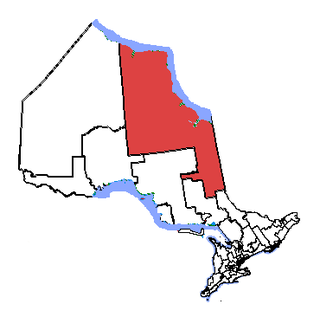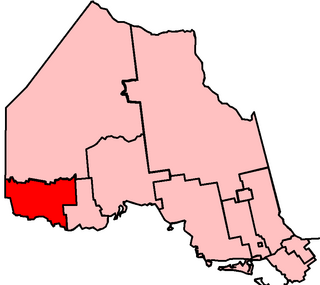
Fort William was a city in Ontario, Canada, located on the Kaministiquia River, at its entrance to Lake Superior. It amalgamated with Port Arthur and the townships of Neebing and McIntyre to form the city of Thunder Bay in January 1970. Since then, it has been the largest city in Northwestern Ontario. The city's Latin motto was A posse ad esse, featured on its coat of arms designed in 1900 by town officials, "On one side of the shield stands an Indian dressed in the paint and feathers of the early days; on the other side is a French voyageur; the cent[re] contains a grain elevator, a steamship and a locomotive, while the beaver surmounts the whole."

Thunder Bay District is a district and census division in Northwestern Ontario in the Canadian province of Ontario. The district seat is Thunder Bay.

Timmins—James Bay is a federal electoral district in Ontario, Canada, that has been represented in the House of Commons of Canada since 1997. Its population in 2011 was 83,104.

Northwestern Ontario is a secondary region of Northern Ontario in the Canadian province of Ontario which lies north and west of Lake Superior and west of Hudson Bay and James Bay. It includes most of subarctic Ontario. Its western boundary is the Canadian province of Manitoba, which disputed Ontario's claim to the western part of the region. Ontario's right to Northwestern Ontario was determined by the Judicial Committee of the Privy Council in 1884 and confirmed by the Canada Act, 1889, of the Parliament of the United Kingdom. In 1912, the Parliament of Canada by the Ontario Boundaries Extension Act gave jurisdiction over the District of Patricia to Ontario, thereby extending the northern boundary of the province to Hudson Bay.

Oliver Paipoonge is a township in the Canadian province of Ontario, located directly west of the city of Thunder Bay. The municipality was formed on January 1, 1998, with the amalgamation of the former Township of Oliver and Township of Paipoonge. It contains several communities within its boundaries, including Baird, Carters Corners, Harstone, Kakabeka Falls, Lee, McCluskeys Corners, Millar, Murillo, Rosslyn, Slate River Valley, Stanley and Twin City. The remainder of the municipality is agricultural or rural.

Fort Frances is a town in, and the seat of, Rainy River District in Northwestern Ontario, Canada. The population as of the 2021 census was 7,466 Fort Frances is a popular fishing destination. It hosts the annual Fort Frances Canadian Bass Championship.
Antigonish was a federal electoral district in Nova Scotia, Canada, that was represented in the House of Commons of Canada from 1867 to 1917. It was created in the British North America Act, 1867. The federal riding was dissolved in 1914 into the riding of Antigonish—Guysborough. It consisted of the County of Antigonish.

Kenora is a federal electoral district in Ontario, Canada, that has been represented in the House of Commons of Canada since 2004.

Sault Ste. Marie is a federal electoral district in Ontario, Canada, that has been represented in the House of Commons of Canada since 1968.

Thunder Bay—Rainy River is a federal electoral district in Ontario, Canada, that has been represented in the House of Commons of Canada since 2004. It first elected a member in the 2004 federal election.

Thunder Bay—Superior North is a federal electoral district in Ontario, Canada, that has been represented in the House of Commons of Canada since 1976.
Kenora—Rainy River was a federal electoral district represented in the House of Commons of Canada from 1925 to 2004. It was located in the province of Ontario. This riding was created in 1924 from parts of Fort William and Rainy River and Port Arthur and Kenora ridings.
Cochrane was a federal electoral district in the province of Ontario, Canada. It was represented in the House of Commons of Canada from 1935 to 1997.
Port Arthur was a federal electoral district represented in the House of Commons of Canada from 1935 to 1979. It was located in the province of Ontario. This riding was created in 1933 from parts of Port Arthur—Thunder Bay riding.
Thunder Bay was an electoral district in the northwestern part of the province of Ontario, Canada, that was represented in the House of Commons of Canada from 1968 to 1979, and the Legislative Assembly of Ontario until 1975.

Kenora—Rainy River is a provincial electoral district (riding) in northwestern Ontario, Canada, that has been represented in the Legislative Assembly of Ontario since 1999. It was created from Kenora, most of Rainy River and part of Lake Nipigon. The boundaries of the new district corresponded with the Kenora—Rainy River federal riding, until it was abolished in 2003. The provincial riding will continue to exist.

Thunder Bay—Superior North is a provincial electoral district in Ontario, Canada, that has been represented in the Legislative Assembly of Ontario since 1999.

Timmins—James Bay was a provincial electoral district in Ontario, Canada, that was represented in the Legislative Assembly of Ontario from 1999 to 2018. Its population in 2001 was 84,001.
King's Highway 130, commonly known as Highway 130, is a provincially maintained highway in the Canadian province of Ontario. It begins at a junction with Highway 61 and travels 15.4 km (9.6 mi) north-west to the Trans-Canada Highway, Highway 11 and Highway 17, west of Thunder Bay. Highway 130 is a short connecting highway, and passes entirely through the outskirts of Thunder Bay, connecting several minor communities and providing a shortcut for traffic travelling from the south to the west or vice versa. The speed limit along the highway is 80 km/h (50 mph); it is patrolled by the Ontario Provincial Police.












